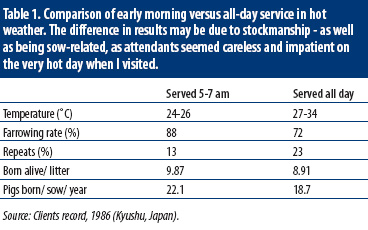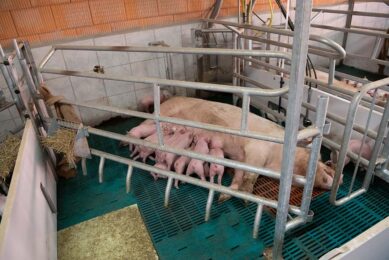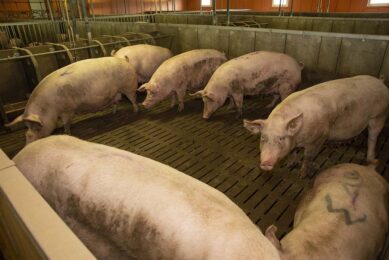What the textbooks don’t tell you about… Hot weather

Summer’s here in the Northern hemisphere, and with it those listless sows and languid gilts, reduced appetite, stuffy, overhot farrowing houses, sunburn for the outdoor pigs – and irritable stockpeople trying to keep pace with it all! Stimulated by some excellent and mainly new advice from PIC recently, I realised that the pig textbooks I have (and I have most of them) are not all that ‘hot’ on warm weather advice, so perhaps a few updating remarks may be useful.
Things the textbooks do mention
Obvious but vital are:
• Make sure there is plenty of water.
• Check up on ventilation – fans, fan belts, louvres and inlets.
• Don’t overcrowd.
• Clean all thermometers.
• Wrong- mucking? Look into the causes.
• Consider spray cooling growers – equipment is available now at a reasonable cost.
• Paint roofs white (this reduces internal radiation by up to one-third).
• Serve/ inseminate at the two cooler times of the day (repeats are 50% less and litter size can increase by one born-alive per farrowing). Boars need cooling as well as females – don’t forget them, as the damage to litter size due to poor sperm quality can occur when the hot spell is well over.
And so on – I won’t repeat the obvious; this column is about what the textbooks omit – not what they mention.
PIC ‘bon-mots’
The PIC technical Services Team’s latest advice caught my eye. Some experienced producers are already doing some of the following, but many are not. Where appropriate I add some experiences of my own, having spent many tours in both ‘hot-wet’ and ‘hot-dry’ parts of the world. I have made minor adjustments to their wording which I trust improves clarity.
PIC advises, in hot weather…
• Any movement of pregnant females to farrowing, or weaned sows to the weaning area should be done as early in the day as possible so as to avoid stress.
• Increase gilt flow by 10 to 15% for eight to 12 weeks.
• House parity 1 and thin sows together at weaning.
Comment: Bullying from heavy- weight matrons is always a bad thing, but is especially damaging to implantation. Vital advice in hot weather.• Feed weaned sows twice a day.
Comment: Bullying from heavy- weight matrons is always a bad thing, but is especially damaging to implantation. Vital advice in hot weather.• Feed weaned sows twice a day.
• Heat checking: Heat check weaned sows, gilts and 21-day bred groups twice per day. Heat check open and new-intake females once a day.
• Start boar exposure to weaned sows on the day of weaning. Leave boars in front of the weaned sow after the heat check for one hour.
• When breeding, use two boars. The second boar should be 1.5 m behind the first boar for extra stimulation.
Comment: New to me – is this feasible?• PIC says that one boar should be able to stimulate four sows at a time, but do not inseminate more than four sows at once.
• Do not over-condition sows in pregnancy.
• Maximise lactation feed intake.
Comment: Notoriously difficult in hot weather. Feeding wet helps considerably, as my hot-weather clients have found. The nutritionist can reformulate lactation diets from the ingredient make-up, which lowers the heat increment from digesting food.• Full feed from days two to three after farrowing.
Comment: Notoriously difficult in hot weather. Feeding wet helps considerably, as my hot-weather clients have found. The nutritionist can reformulate lactation diets from the ingredient make-up, which lowers the heat increment from digesting food.• Full feed from days two to three after farrowing.
• Watch for off-feed sows and take
their temperatures the day after farrowing. Treat those with a temperature of 39˚C or above – and see your vet for the procedure.
• Be prepared to assist more sows at farrowing than in the cooler months. Comment: Assisted farrowing at any time, in my experience, is an underrated procedure which I should like to see become standard practice. Not always feasible, but breeders give up too easily on the understandable objections. Every farm I have visited since 2005 which has bitten this particular bullet has reported considerably more piglets reared/ litter.
• Early wean young sows that start to lose too much weight in farrowing.
• Consider culling older sows (Parity 5+) and sows in extremely poor body condition.
Last but not least: The table from my files adds some back-up information.











